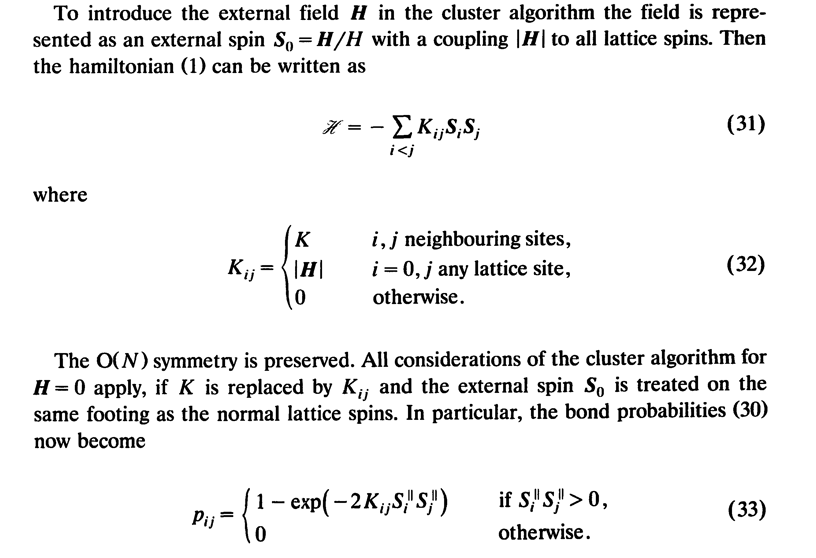class: center, middle # An efficient cluster algorithm for spin systems in a symmetry-breaking field ## Jaron Kent-Dobias & James Sethna ### Cornell University ## 9 March 2018 --- # Spin systems Described by Hamiltonians $$\mathcal H=-\sum_{\langle ij\rangle}Z(s_i,s_j)-\sum_iH(s_i)$$ for \\(Z\\) invariant under rotations \\(r\\): \\(Z(r(s),r(t))=Z(s,t)\\). <table style="border-collapse: collapse; table-layout: fixed; width: 80%; margin: auto;"> <thead style="border-bottom: 2px solid #000;"> <tr> <td class="first"></td><td>\(s\)<td>\(r\)</td><td>\(Z(s_i,s_j)\)</td><td>\(H(s)\)</td> </tr> </thead> <tbody> <tr> <td class="first">Ising model</td><td>\(\{-1,1\}\)</td><td>\(s\mapsto-s\)</td><td>\(s_is_j\)</td><td>\(Hs\)</td> </tr> <tr> <td class="first">Order-\(n\) model</td><td>\(S^n\)</td><td>\(\mathop{\mathrm{SO}}(n)\) (rotation)</td><td>\(s_i\cdot s_j\)</td><td>\(H\cdot s\)</td> </tr> <tr> <td class="first">Potts model</td><td>\(\mathbb Z/q\mathbb Z\)</td><td>addition mod \(q\)</td><td>\(\delta(s_i,s_j)\)</td><td>\(\sum_iH_i\delta(i,s)\)</td> </tr> <tr> <td class="first">Clock model</td><td>ℤ/<i>q</i>ℤ</td><td>addition mod \(q\)</td><td>\(\cos(2\pi\frac{s_i-s_j}q)\)</td><td>\(\sum_iH_i\cos(2\pi\frac{s-i}q)\)</td> </tr> </tbody> </table> Relatively simple with extremely rich behavior, phase transition galore! --- class: split-40 # Local Monte Carlo: Not Great .column[ Standard approach to modelling arbitrary stat mech system: metropolis. 1. Pick random spin. 2. Pick random rotation \\(r\\). 3. Compute change in energy \\(\Delta\mathcal H\\) resulting from taking \\(s\\) to \\(R(s)\\). 4. Take \\(s\\) to \\(R(s)\\) with probability \\(\max\\{1,e^{-\beta\Delta\mathcal H}\\}\\). Problem: Scales very poorly near phase transitions. Correlation time *τ* at critical point, *t* <sup>– *z/ν*</sup> `\(\tau\sim t^{-z/\nu}\)` approaching it. `\(z\)` takes large integer values for Ising, order-`\(n\)`, Potts model critical ] .column[ <video width="320" height="320"><source src="figs/metropolis_ising_zerofield.webm" type="video/webm"></video> ] --- class: split-40 # Wolff: wow, what a solution .column[ 1. Pick random spin, add to cluster. 2. Pick random rotation `\(R\)`. 3. For every neighboring spin, add to cluster with probability `\(\min\{0,1-e^{-\beta(Z(R(s),R(t))-Z(R(s),t))}\}\)`. 4. Repeat 3 for every spin added to cluster. 5. Transform entire cluster with rotation `\(R\)`. Relies on symmetry of *Z* Fast near the critical point: early studies thought `\(z\)` was zero, actually 0.1–0.4. ] .column[ <video width="320" height="320"><source src="figs/wolff_ising_zerofield.webm" type="video/webm"></video> ] --- # We want to apply an external field, though The external field `\(H\)` is not invariant under global rotations! Let's make it that way: introduce an extra spin `\(s_0\)`, let `\(R_s\)` be the rotation that takes `\(s\)` to the identity `\[ \tilde Z(s_i,s_j)= \begin{cases} Z(s_i,s_j) & \text{if $i,j\neq0$}\\ H(R_{s_0}s_i) & \text{if $j=0$}\\ H(R_{s_0}s_j) & \text{if $i=0$} \end{cases} \]` Exact correspondence between expectation values of operators in old and new models: if `\(A(s)\)` is an observable on old model, `\(\tilde A(s_0,s)=A(R_{s_0}s)\)` has the property `\[ \langle\tilde A\rangle=\mathop{\mathrm{Tr}}\nolimits_s\mathop{\mathrm{Tr}}\nolimits_{s_0}\tilde A(s_0,s)=\mathop{\mathrm{Tr}}\nolimits_sA(s)=\langle A\rangle \]` ---  ---  --- # Why is the extended method useful? <img src="figs/vector-1.svg" alt="order-n" style="float: left;"/> <img src="figs/vector-2.svg" alt="order-n" style="float: right;"/> <span style="font-size: 40pt; overflow: hidden; height: 6.5em; text-align: center; align-items: center; display: inline-flex; position: static; float: center"> <i>R</i> <br>→</span> --- # Why is the extended method useful? <img src="figs/potts.svg" alt="order-n"/> --- # Correlation time scaling Correlation time scales consistently in the whole phase space! <img src="figs/autocorr-scaling-isotherm.png" style="float: left; width: 48%" /> <img src="figs/autocorr-scaling-temp.png" style="float: right; width: 48%" /> --- # Metastable state direct measurement